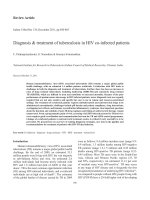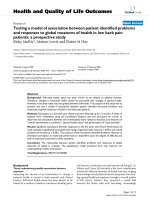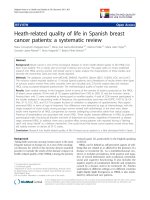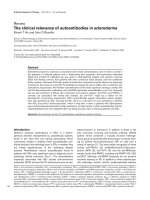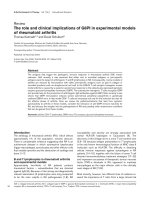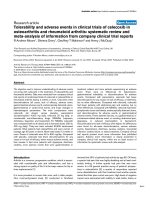Clinical pharmacokinetics of tacrolimus in asian liver transplant patients
Bạn đang xem bản rút gọn của tài liệu. Xem và tải ngay bản đầy đủ của tài liệu tại đây (2.54 MB, 184 trang )
CLINICAL PHARMACOKINETICS OF TACROLIMUS
IN ASIAN LIVER TRANSPLAN T PATIENTS
SAM WAI JOHNN
(B.Sc.(Pharm.)(Hons.), NUS)
A THESIS SUBMITTED FOR THE DEGREE OF
DOCTOR OF PHILOSOPHY OF PHARMACY
DEPARTMENT OF PHARMACY
NATION AL UNIVERSITY OF SINGAPORE
2003
II
AC KN O WLEDG EM ENTS
I would like to express my special thanks to:
1) My supervisor Associate Professor Ho Chi Lui, Paul and co-supervisor
Associate Professor Chan Sui Yung, for their continuous support and for
leadin g me through all these y ears.
2) My collaborators, Associate Professor Quak Seng Hock (Department of
Paediatrics, NUS), Associate Professor Lee Kan g Hoe, Associate
Professor Lim Seng Gee (both of Department of Medicine, NUS),
Associate Professor K. Prabhakaran (Dep artment of Surgery , NUS) for the
provision of patients’ data and samples.
3) My collaborator, Associate Professor B.G. Charles, from the School of
Pharmacy and Australian Centre for Paediatric Pharmacok inetics, The
University of Queensland, Australia, for his help on data analysis.
4) My collaborator, Dr Michael J. Holmes, from the Tropical M arine Science
Institute of Singapore, for his help on the LCM S/M S method
development.
5) Ms Tham Lai San, M s Lim Siew M ei (both of Department of Pharmacy,
NUH) and members of the Liver Transplant Group (NUH), for the help
and coordination in patient blood sampling.
6) Associate Professor Go Mei Lin and Associate Professor Heng Wan Sia,
Paul who are the former Acting Head and p resent Head of the Dep artment
III
of Pharmacy , NUS, resp ectively , for providing the necessary research
facilities.
7) The technical and administrative personnel of the Department of
Pharmacy, NUS: Mr. Tang Chong Wing, Ms Ng Sek Eng, Ms Ng Swee
Eng, Mrs Teo Say M oi and M s Napsiah Bte Suyod.
8) Fellow postgraduate students in the laboratory for their valuable friendship
and assistance in times of need.
9) Janssen-Cilag (A division of Johnson & Johnson Pte Ltd) Singapore for
the kind donation of Prograf
capsules.
10) Fujisawa Pharmaceutical Co., Ltd, Japan for the kind donation of pure
tacrolimus.
11) NUS for the provision of the Research Scholarship throughout the period
of my candidature.
IV
TAB LE O F C O N TENTS
LIST OF TABLES VII
LIST OF FIGURES IX
PUBLICATIONS XII
LIST OF ABBREVIATIONS XIII
SUMMARY XVI
SECTION 1. INTRODUCTION 1
1.1. Transplantation Immunology 2
1.1.1. Clinical transplantation 2
1.1.2. Clinical characteristics of allograft rejection 2
1.1.3. Prevention or reduction of rejection 6
1.2. Tacrolimus 8
1.2.1. Discovery and development 8
1.2.2. Physicochemical properties and dosage forms 9
1.2.3. Mechanism of action and toxicity 11
1.2.4. Analytical methods 14
1.2.5. Pharmacokinetics 16
1.2.6. Drug interactions 19
1.2.7. Tacrolimus immunosuppressive therapy optimisation 21
1.2.7.1 Therapeutic drug monitoring 21
1.2.7.2 Pharmacogenomics and pharmacogenetics 25
1.3. Literature Review 29
V
SECTION 2. RESEARCH GOAL AND OBJECTIVES 33
SECTION 3. POPULATION PHARMACOKINETICS OF 35
TACROLIMUS IN AS IAN PAED IAT RIC LIVER
TRANSPLANT PATIENTS
3.1. Study Aims 36
3.2. Methods 38
3.3. Results 44
3.4. Discussion 60
SECTION 4. POPULATION PHARMACOKINETICS OF 69
TACROLIMUS IN ASIAN ADULT AND PAEDIATRIC
LIVER TRANS PLANT PATIENTS
4.1. Study Aims 70
4.2. Methods 70
4.2.1. Chemicals and materials 70
4.2.2. Preparation of standard, internal standard 71
and quality controls
4.2.3. Calibration and validation 73
4.2.4. Sample preparation 74
4.2.5. Blood sampling 75
4.2.6. Bioanalytical assay 75
4.2.7. Data analysis 77
VI
4.3. Results 85
4.3.1. HPLC/MS/MS assay 85
4.3.2. Calibration and validation 85
4.3.3. Patients and data collection 93
4.3.4. Data analysis 96
4.4. Discussion 136
SECTION 5. CONCLUSIONS 147
SECTION 6. REFERENCES 151
VII
LIST OF TABLES
Table
Name Page
1 Classification and mechanisms of action of drug and 7
biological agents currently used in transplantation.
2 Assays for the quantification of Tac and its metabolites in 15
blood and plasma.
3 Agents that may alter Tac metabolism. 22
4 Therapeutic ranges of Tac at various periods post liver 23
transplant
5 PK parameter values of Tac in adult transplant recipients 30-31
6 PK parameter values of Tac in paediatric transplant recipients 32
7 Characteristics of patients included in the study. 46
8 Sensitivity analysis of k
a
values used in ADVAN 2 49
TRANS 2 subroutine.
9 Comparison of interpatient and intrapatient random effects 50
models.
10 Summary of univariate analysis showing covariate models 51
with significant effects on CL, V or F of Tac.
11 Summary of multivariate analyses with forward selection. 53
12 Postliver transplantation population PK of Tac after 59
intravenous and oral administration in Asian paediatric
patients.
13 M ean p arameters of the calibration curv es for Tac. 89
14 Mean peak area ratios ± s.d. of the (A) whole blood, and (B)
plasma calibration curves shown in Figure 11 91
15 Intra-day accuracy and p recision for quantification of Tac in 91
whole blood and plasma samples at different concentrations.
VIII
16 Inter-day precision for Tac quantified in whole blood 92
(n = 18) and plasma (n = 18) samples, respectively.
17 Recoveries of Tac and ascomycin from whole blood 92
and plasma (n = 6).
18 Characteristics of patients included in the study. 95
19 Path taken to the final GAM for the CL/F of Tac. 101
20 Path taken to the final GAM for the V/F of Tac. 101
21 Summary of the results on the principal PK models 122
tested (step-up procedure).
22 ∆OBJF when each of the Θs of the covariates appearing 123
in the final NONMEM model for Tac is set to zero
(step-down procedure).
23 Covariate selection by regression method and NONMEM. 123
24 Final population PK model of Tac in Asian adult and 125
paediatric liver transplant patients and its parameters.
25 Final population PK model of Tac in Asian liver transplant
patients and its parameters estimated using FOCE. 126
26 Case deletion diagnostics for evaluation of final model 132
estimates.
IX
LIST OF FIGURES
Figure
Name Page
1 Chemical structure of Tac (FK506). 11
2 Tac mechan ism of action. 13
3 A schematic rep resentation
of the one-compartment with 47
first-order absorption and elimin ation PK model.
4 Scatterplot of predicted versus observed Tac whole blood 54
concentration in the population (index) group
(n = 16 patients) of the final model.
5 Predictive performance of the final model (n = 4 patients). 55
Scatterplot of weighted residual versus predicted Tac whole
blood concentration.
6 Longitudinal assessment of the predictive performance of the 57
final population model in 2 representative patients from the
validation dataset: (a) 1 year-old male; and (b) 1 year-old
female.
7 Profile of age-normalised CL (predicted by the population 58
model) vs age of patient.
8 Chemical structure of ascomycin. 71
9 Fragmentation pathway of Tac leading to the loss of 210 Da. 86
10 MRM chromatograms of (A) whole blood spiked with 0.25 87-88
ng/mL of Tac; (B) whole blood spiked with 100 ng/mL of Tac;
(C) whole blood spiked with 25 ng/mL of ascomycin; and
(D) clinical sample containing 40.3 ng/mL Tac.
11 Calibration curves of Tac in human (A) whole blood; and 90
(B) plasma.
12 Frequency distribution of whole blood samples by collection 97
time intervals.
13 Observed whole blood Tac concentrations (DV) vs time after 98
dose (TAD) plotted on a semilogarithmic scale.
X
14 Basic goodness of fit plots for the basic population model. 100
15 Results of GAM for CL/F. 102
16 Results of GAM for CL/F, showing the Akaike plot of 103
CL/F.
17 Results of GAM for V/F. 104
18 Results of GAM for V/F, showing the Akaike plot of V/F. 105
19 Results of bootstrap of the GAM for CL/F, showing 107
(A) total frequency of covariates for CL/F; and
(B) inclusion frequency of non-linear models for CL/F.
20 Results of bootstrap of the GAM for CL/F, showing the 108
most common one to four covariate combinations for CL/F.
21 Results of bootstrap of the GAM for CL/F, showing model 109
size distribution for CL/F.
22 Results of bootstrap of the GAM for CL/F, showing stability 110
of inclusion probability of covariates for CL/F.
23 Results of bootstrap of the GAM for V/F, showing (A) total 111
frequency of covariates for V/F; and (B) inclusion frequency
of non-linear models for V/F.
24 Results of bootstrap of the GAM for V/F, showing the most 112
common cov ariate combinations for V/F.
25 Results of bootstrap of the GAM for V/F, showing the model 113
size distribution for V/F.
26 Results of bootstrap of the GAM for V/F, showing the 114
stability of inclusion p robability of covariates for V/F.
27 Regression tree (“unpruned”) of CL/F. 116
28 Results from exploring the optimal tree size using 117
cross-validation.
29 Regression tree (“pruned”, size 3) of CL/F. 118
30 Regression tree (“unpruned”) of V/F. 119
XI
31 Results from exploring the optimal tree size using 120
cross-validation.
32 Regression tree (“pruned”, size 2) of V/F. 121
33 Basic goodness of fit plots for the final population model. 127
34 WRES vs PRED for the final population PK model. 128
35 Histogram with density line plots showing the distribution 129
of (A) ETA 1; and (B) ETA 2 of the final model.
36 Whole blood Tac concentration-time profiles from (A) a 130
14 year old male paediatric patient; and (B) a 60 year old
male adult patient, showing measured (●), population
predicted (▲) and individual predicted (■) concentrations
from the full p opulation PK model for Tac.
37 Relationships between (A) age and CL/F; and (B) age and 133
WT-normalized CL/F.
38 Relationships between (A) age and V/F; and (B) age and 134
WT-normalized V/F.
39 Relationship between age and WT-normalized dose 135
needed to achieve a desired steady-state whole blood
trough concentration of 10 ng/mL.
40 Individual estimates obtained for the t
½
in all patients 143
included in the dataset as plotted against (A) Tac CL/F; and
(B) Tac V/F.
41 M odel-p redicted Tac doses (mg/k g/12hr) required to reach 144
a target steady-state trough concentration of 10 ng/mL in
(A) 15 paediatric patients; and (B) 16 adult patients.
XII
PUB LICAT IO NS
International Refereed Publication
1) W.J. Sam, M . Aw, S.H. Quak, S.M. Lim, B.G. Charles, S.Y. Chan & P.C. Ho.
Population pharmacokinetics of tacrolimus in Asian paediatric liver transplant
patients. British Journal of Clinical Pharmacology 2000; 50: 531-541.
2) W.J. Sam, M .J. Holmes, L.S. Tham, S.H. Quak, K.H. Lee, S.G. Lim, K.
Prabhakaran, S.Y. Chan & P.C. Ho. Population pharmacokinetics of tacrolimus in
Asian adult and paediatric liver transplant patients. Manuscript in preparation.
Conference Paper
W.J. Sam, M . Aw, S.H. Quak, S.M. Lim, B.G. Charles, S.Y. Chan & P.C. Ho.
Pharmacokin etics of tacrolimus in Asian paediatric liv er transplant p atient: a p opulation
analysis, July 2000. Joint meeting of VII World Conference on Clinical Pharmacology &
Therapeutics IUPHAR – Division of Clinical Pharmacology & 4
th
Congress of the
European Association for Clinical Pharmacology & Therapeutics, Florence, Italy.
XIII
LIST OF ABBREVIATIONS
Abbre viation
Full name
AGE Age
AIC Akaike’s information criterion
ALB Albumin
ALT Alanine amino transferase
APC Antigen-p resenting cells
APH Alkaline phosp hatase
AST Aspartate amino transferase
AUC Area under curve
BSA Body surface area
CL Clearan ce
CL/F App arent clearance
C
max
Maximum dru g con centration
C
min
Minimum drug concentration
CREA Creatinine
CV Coefficient of variation
CYP Cytochrome
F Bioavailability
FO First-order
FOCE First-order conditional estimation
GAM Generalized additive modeling
GEN Gender
XIV
GGT Gamma glutamyl transferase
HCT Haematocrit
HPLC/MS/MS High-p erformance liqu id chromatograp hic/mass
spectrophotometric/mass spectrop hotometric
HLA Human leukocyte antigen
HT Height
IFN Interferon
IL Interleukin
IV Intravenous
LDH Lactate dehy drogenase
LOQ Limit of quantification
M E M ean prediction error
MHC M ajor histocompatibility comp lex
MFO Mixed function oxidase
MDR-1 Multidrug-resistance 1
M RM M ultip le-reaction monitoring
MS Mass spectrometric
NF-AT Nuclear factor of activated T cells
NONM EM Nonlinear mixed eff ects model
OBJF Objective function
OKT3 M uromonab-CD3
P-glycop rotein Permeability-gly coprotein
PD Pharmacodynamics
PK Pharmacokin etics
XV
POD Post-operative days
PROT Total protein
RMSE Root mean square error
RSS Residual sum of squares
SNP Single nucleotide polymorphism
SD Standard deviation
t
abs
Absorption half-life
t
½
Elimination half- life
t
max
Time to maximum blood concentration
Tac Tacrolimus
TBM Tree-based modeling
TDM Therapeutic drug monitoring
TLI Total lymphoid irradiation
TNF Tumour necrosis factor
TOTBIL Total bilirubin
UREA Urea
V Volume of distribution
V/F Apparent volume of distribution
V
SS
Volume of distribution at steady state
WT Weight
XVI
S UMMARY
The general aim of the thesis is to investigate the population pharmacokinetics (PK)
of tacrolimus (Tac) (FK506) in the local Asian liver transplant recipients so as to identify
possible relationships between clinical covariates and population parameter estimates.
This can be achieved by (A) determining the population PK of Tac in the local Asian
paediatric liver transplant recip ients, which represents a special subp op ulation with
special PK characteristics, and (B) determining the p opulation PK of Tac in the local
Asian adult and paediatric liver transplant recipients.
In the first study, the population pharmacokinetics (PK) of intravenous and oral Tac
was determined in 20 Asian paediatric patients, aged 1-14 years, after liver
transplantation. Population modeling using the nonlinear mixed effects model
(NONM EM ) program was performed on the population data set, assuming a one-
compartment model with first-order absorption (k
a
fixed to 4.5 hr
-1
) and elimination.
The final optimal population models identified the following relationships: CL
(L/hr) = 1.46
•
[ 1 + 0.339 • ( AGE (yr) – 2.25 ) ]; V (L) = 39.1 •
[ 1 + 4.57 • ( BSA (m
2
)
– 0.49 ) ]; F = 0.197 •
[ 1 + 0.0887 • ( WT (kg) – 11.4 ) ] and F = 0.197 •
[ 1 + 0.0887 • (
WT (kg) – 11.4 ) ]
•
[ 1.61 ], if the total bilirubin ≥ 200 µmol/L. The mean p op ulation
estimates of CL, V and F were 1.46 L/hr, 39.1 L and 0.197, respectively. The interpatient
variabilities (CV %) in CL, V and F were 33.5 %, 33.0 % and 24.1 %, respectively.
XVII
For the second study, the population PK of oral Tac was determined in 31 Asian
adult and paediatric patients, aged 1-67 years, after liver transplantation. A one-
comp artment PK model with first-order absorption and elimin ation was used to describe
the disposition of Tac in these patients.
The final optimal population model related CL/F to body weight, the level of serum
creatinine and the level of alkaline phosphatase, and produced the following relationship:
CL/F (L/hr) = 14.1 + 0.237
*
[WT (kg)-55] − 0.0801
*
[CREA (µmol/L)-60] and CL/F
(L/hr) = 14.1 + 0.237
*
[WT (kg)-55] − 2.93 − 0.0801
*
[CREA (µmol/L)-60], if the alkaline
phosphatase is ≥ 200 U/L. The final optimal population model related V/F to body height
and the level of haematocrit of the patient, and produced the following relationship: V/F
(L) = 217 – 7.83
*
[HCT (L/L)-31.1] + 179
*
[HT (m)-1.61].
The mean population estimates of CL/F and V/F in the Asian adult and paediatric
liver transplant patients were 14.1 L/hr and 217 L, respectively. Reasonably large
interindividual variabilities of 65.7 % and 63.8 % were estimated for CL/F and V/F,
resp ectively.
The population models have identified significant relationships in Asian liver
transplant p atients between the PK of Tac and arthrop ometric characteristics of the
patients, as well as the clinical conditions of the patients. Using these models, in
conjunction with Bay esian forecasting, a truly individualized immunosuppressive therapy
can be developed and applied.
1
INTRODUCTION
2
1.1. Transplantation Immunology
1.1.1. Clinical transplantation
Transplantation is the act of transferring cells, organs or tissues from one site or
individual to another. It provides effective treatment for various end-stage organ diseases
of the heart, lung, cornea, liver, kidney and bone marrow
As the majority of the transplants is performed between genetically different
individuals of the same species (allografts), the immunological response of the recipient
to the antigens from the donor graft, must be considered. The result of this immune
response, if left unchecked, will lead to the rejection of the transplanted tissue and both
cellular (or lymphocyte-mediated) and humoral (antibody-mediated) mechanisms are
involved.
1.1.2. Clinical characteristics of allograft rejection
Rejection can be defined as graft damage arising from the response of the
recipient’s immune system to the transplanted organ. It involves cell- and antibody-
mediated organ injury occurring as the result of recognition of allograft as nonself
(Arakelov and Lakkis, 2000). This process is caterorised into three major types:
hyperacute, acute, and chronic.
3
Hyperacute rejection occurs when an abrup t loss of allogr aft function occurs
within minutes to hours after circulation is established in the allograft. This process is
mediated by preexisting antibodies to allogeneic antigens on the vascular endothelial
cells within the donor organ (Hanto et al., 1987). These antibodies fix complement
thereby promoting intravascular thrombosis and leading to rapid occlusion of graft
vasculature and rapid rejection of the graft (Hammond et al., 1993). Donor recipient
human leukocyte antigen (HLA) and ABO blood-group cross-matching are used to
prevent hyperacute rejection (Abbas et al., 1994). There is currently no
immunosuppressive therapy effective in managing hyperacute rejection. Clinical
symptomatology associated with hyperacute rejection varies depending on allograft type,
but typically reflects intensive organ failure.
Acute rejection may occur within days of transplantation in the untreated
recipient or may appear suddenly months or even years later, when immunosuppression
has been employed and terminated. It is a combined process in which both cellular and
humoral tissue injuries play a part (Oluwole et al., 1989). However, cell-mediated
immunity mediated by T cells is the primary cause of acute rejection in any one patient. It
is characterized by necrosis of parenchymal cells within the donor organ. Acute rejection
can be initiated when graft injury produces an up-regulation of adhesion molecules on
endothelial cell lining blood vessels in the graft (Nair and Morris, 1995). Host T-cell
recep tors bind to these adhesion molecu les incr easin g their transit time through graft
vessels and promoting their migration into allograft tissue. Subsequently two varieties of
cells – T lymphocytes and antigen-presenting cells (APCs) – are recruited (Billingham et
4
al., 1956). The professional APCs are critical to the immune response. They include
dendritic cells and macrophages that bind antigen and present it to T cells in the form of
short peptides bound to the major histocompatibility complex (M HC) of APCs
(Rammensee et al., 1993; Germain, 1994). MHC is one set of the many
histocomp atibility molecules that has a p redominant influence on tissue comp atibility and
is by far the most p olymorp hic (Klein et al., 1993). The gene products of the M HC
molecules in humans are called human leukocyte antigen (HLA). There are two main
typ es of M HC molecules that are imp ortant for allograft transp lantation: class I and II.
The HLA class I molecules are present on all nucleated cell surface to disp lay antigenic
peptides to the cytotoxic cells (Harris and Gill, 1986). In contrast class II molecules are
found almost exclusively on cells associated with the immune system: the professional
APC found in lymphoid tissues and activated T cells (Daor et al., 1984).
Macrophage and polymorphonuclear leukocyte activity dominates the early phase
of tissue injury. M acrophages produce cytotoxic mediators such as interleukin-1 (IL-1)
and tumour necrosis factor (TNF) upon recognition of pathogens or foreign antigens.
These cytokines function to increase recruitment of of T-cells to the graft site. The
activation of T-cells is the p rimary factor associated with acute rejection (Gowans et al.,
1962). Activated T-cells also secrete inflammatory cytokines, which interfere in
microvascular processes to an extent that vascular insufficiency contributes to endothelial
cell death. Clinical signs which may be associated with acute rejection include gener al
malaise, fatigue, myalgia, low- grade f ever and p ain or tenderness at the graft site (excep t
in heart transplant as surgical denervation processes cannot be completely reversed).
5
Other symptoms may also be observed, such as hypertension, weight gain, decreased
urine output and increased serum creatinine in acute kidney rejection.
Chronic rejection, or late graft failure, is an irreversible gradual deterioration of
graft function that occurs in many allografts months to years after transplantation (Häyry
et al., 1993). It is characterized by intimal thickening and fibrosis leading to luminal
occlusion of the graft vasculature (Abbas et al., 1994). For example, cardiac allograft
vasculopathy has been detected angiographically in 44% of heart transplant recipients at
3 years (Uretsky et al., 1987). This form of rejection involves a variety of immune-
system components: T cells, cytokines, macrophages, and adhesion molecules (Azuma
and Tilney, 1994). Both immunologic and nonimmunologic factors appear to be involved
in the ultimate impairment of organ functions. Acute rejection episodes, inadequately
treated acute rejection, insufficient long-term immunosuppression therapy, preservation
injury, lipid abnormalities, and infection have all been associated with chronic rejection
(Ventura et al., 1995).
The immunology of allograft rejection is not yet fully understood. However, the
increasin g insight into the comp lexities of these host mechanisms holds p romise for
further improvement in knowledge, their attenuation by both chemical and biological
agents and eventual success in the production of transplant tolerance, which is the long-
term accep tance of the allogr aft by the recip ient.
6
1.1.3. Prevention or reduction of rejection
Since the vast majority of transplants come from incompatible unrelated donors,
nonpharmacologic and pharmacologic means of immunosuppression can be given to
control transplant immunity so that rejection can be prevented or controlled and that the
recip ient develop s a long-term accep tance (or tolerance) of the transplant.
Nonpharmacologic immunosuppression
Total lymphoid irradiation (TLI) is considered an alternative immunosuppressive
therapy for highly sensitised patients who have received p rior organ transp lantation
(Slavin et al., 1980). By targeting x-rays to lymphoid tissues, using small fractionated
doses to minimize side effects, and discontinuing therap y with the app earance of adverse
effects, TLI has been used successfully in renal transplant patients in combination with
low doses of immunosuppressive drugs (Saper et al., 1988).
In some cases, prior intravenous exposure to donor antigens (especially by blood
transfusions) can cause prolonged or indefinite graft survival, even though one might
expect hyperacute graft rejection to occur. This phenomenon is called “active
enhancement of graft survival.” Active enhancement of graft survival has been employed
clinically using donor specific transfusions (Newton and Anderson, 1979).
Pharmacologic immunosuppression
7
Pharmacolo gic agents currently p rovide the p rimary means of
immunosuppression after transplantation. Over the past 40 years, compounds that block
distinct aspects of the immune response have been developed. Immunosuppressive agents
can be classified accord in g to their mechan isms of action as shown in Table 1.
Mechanism of action Example
Lymphokine synthesis inhibitors dependent on
the immunophilin-calcin eurin co mp lex
Cy closporine, Tacrolimus (Tac)
DNA (nucleotide) synthesis inhibitors
a. purine antagonists
b. py rimidine antagonists
c. folate antagon ists
d. alkylators
Azathioprine, mycophenolate mofetil
Brequinar sodium, leflunomide
Methotrexate
Cyclophosphamide
Growth factor / cytokine action modulators
(inhibitors)
Rap amy cin, leflunomid e
Multiple actions / unknown mechanisms of
action
Prednisone, 15-deoxyspergualin
Anti-lymphocyte / endothelial cell biological
agents
Polyclonal anti-lymphocyte globulin,
muromonab-CD3 (OKT3), anti-CD4,
anti-T10, anti-CD52, anti-ICAM-1
Pharmacologic and biologic agents for positive
and negative selection of bone marrow
Cyclop hosp hamide analogs, anti-
CD34 monoclonal antibodies
Table 1. Classification and mechanisms of action of drug and biological agents currently
used in transplantation.
Drug combinations hold the greatest promise for managing transplant-related
immunosuppression. As discussed previously, the allograft rejection process involves
both T and B cells, multiple cytokines, and inflammatory mediators. Selective drug
combinations that p revent comp ensatory immune mech anisms from avo idin g supp ression
8
and that take advantage of proven synergism between agents should provide the most
effective therap y . Drug combinations also allow the use of minimal eff ective doses of
immunosuppressive agents so that drug toxicity is diminished.
The development of immunosuppressive regimens since the mid-1960s has
resulted in the current use of “triple therapy” or “quadruple therapy” as the standard
regimen in most transplant centers. Triple therapy, which is low dose cyclosporine or
Tac, azathioprine, and steroids, takes advantage of the immunosuppressive effects of
cyclosp orine or Tac while minimizing their adverse eff ects. Quadrup le therapy adds anti-
lymphocyte globulin or OKT3 to triple therapy with a delay in the start of cyclosporine
until adequate renal function is established (Deierhoi et al., 1987).
Optimal immunosuppressive therapy entails a careful management of the patient,
which includes proper dosing strategies, measurement of the drug levels in the blood,
monitoring of graft function using biopsy histology and evaluation of potential side
effects of the drug.
1.2. Tacrolimus
1.2.1. Discovery and development
In 1982, workers from Fujisawa Pharmaceuticals (Ibaraki, Japan) started to test a
wide range of fermented broths from Streptomyces for specific inhibitory effects on
